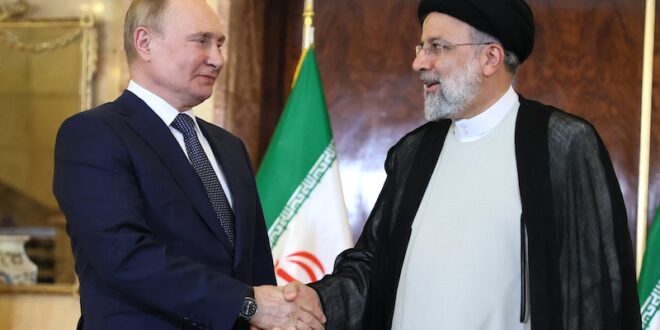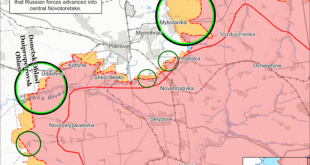Not surprisingly, given Russia’s war against Ukraine, Iran’s decision to supply Moscow with drones and other military technology has attracted some of the most attention around the world (Cursorinfo.co.il, March 30).
And equally unsurprising, given the long-term consequences of any change in east-west and north-south trade routes in the context of rising tensions between Russia and the West, the development of north-south corridors between Russia and Iran has attracted almost as much scrutiny (Rus-shipping.ru, March 28).
Nevertheless, these two sectors are only small parts of a much larger trend in the development of Russian-Iranian relations—namely, the simultaneous increase in Russian investment in Iran and, perhaps to an even greater degree, the increase in Iranian investment in Russia’s regions and republics (see EDM, November 1, 2022). These increases suggest that the two countries are on course to deeper integration. Moreover, the current context, at least in cases where Tehran has more of Moscow wants rather than the other way around, indicates that Iran is moving far more deeply into the Russian Federation than ever before—and with Moscow’s encouragement.
In some respects, current Russian-Iranian relations resembles those between Moscow and Beijing. In this regard, attention has largely focused on what China may be able to give Russia in its current round of hostility with the West and far less on what China has gained from the process—despite the fact that these gains are likely to be far more consequential over the longer haul, an outcome already worrisome to the Kremlin (see EDM, June 16, 2022; March 28).
Up to now, the current development of relations between Russia and Iran has not sparked public concerns in Moscow about similar longer-term consequences; however, the experience of Russian-Chinese relations suggests that some in Moscow may soon be just as worried given the possibility that an increased Iranian presence in Russia’s predominantly Muslim regions could add to the difficulties the Kremlin already faces in these areas. (For comparison, see EDM, May 6, 2021.)
Russian President Vladimir Putin has focused a great deal of attention on developing relations with Iran, first and foremost, to expand the north-south route and then to receive military assistance for his war against Ukraine. During his fifth visit to Tehran since becoming Russian president last summer, Putin opened the way for Iran to expand its influence, first in the Caucasus alongside Russia and then within the Russian Federation itself to help Moscow in places where its own financial and technological bottlenecks have been holding it back. The subsequent deals for Iran to supply drones to Moscow flow from that effort (see EDM, July 22, 2022; November 1, 2022; February 24).
At present, bilateral trade between Russia and Iran amounts to approximately $4.6 billion, and Russia invests far more in Iran than the other way around, supplying just under $2.8 billion of the $4.2 billion for all foreign investment in Iran (Casp-geo.ru, March 17; Abnews.ru, March 23; Iarex.ru, March 27). However, both Moscow and Tehran expect Iranian investment in Russia to skyrocket and transform trade between the two countries from being primarily about agricultural products to involving industrial and chemical materials as well (RT, March 21; Kommersant, March 29).
Some of Tehran’s plans, such as the construction of Iranian trucks and off-road vehicles near St. Petersburg, are clearly all-Russian efforts and are receiving the expected media coverage in Moscow (Bfm.ru, March 28; Motor.ru; Vonauto.ru, March 29). Yet, a large part of this projected growth is set to take place not at the country-to-country level but rather between Iran, on the one hand, and various regions and republics within the Russian Federation, on the other.
And seemingly, this pattern is welcomed and supported by senior Russian officials: Alexey Dedov, the Russian ambassador to Tehran, has stipulated, “The regional aspect of our relationships play a very important role. Along with the strengthening of ties and cooperation between the two countries as a whole—Russia and Iran—relations between the regions are acquiring ever-greater importance.” Dedov’s words were echoed by Iranian Vice President Mohsen Rezaei, who declared: “We are proceeding along a path of strengthening cooperation with Russia as a whole and with its regions as well” (Casp-geo.ru, March 17).
One of these regional links, which Moscow and Tehran expect to increase by 300 percent in the near term and shift from agriculture to industry and petrochemicals, is between Tehran and Bashkortostan, a Muslim republic in the Middle Volga. Two weeks ago, the republic’s head, Radiy Khabirov, led a major delegation to Tehran to discuss the expansion of Iranian investment in Bashkortostan, where he is overseeing the development of both a hub for expanded trade with other regions and a center for the development of drone technology (Bashinform.ru; Haibvestnik.ru, March 14; Ufa.mk.ru, March 26).
At the meetings, Ufa and Tehran agreed to open a direct air route between the two sides—both to increase tourism and to make it easier for businesses to cooperate. The two sides pointedly noted that Moscow had already approved this link; thus, it will likely begin within weeks. That the central Russian government has agreed so readily reflects Moscow’s own weakness and its desire to do anything to attract more investment to the country. But the Kremlin may soon have cause to regret this, as Iran has shown itself adept not only in the production of dual-use technology but also in the exploitation of what could be called “dual-use” development policies—that is, piggybacking on economic projects as well as ideological, cultural and religious programs designed to project and then cement Iranian influence in the regions where it sends investments.
It will certainly not be lost on many observers that Iran is now focusing on a Muslim republic in the heart of Russia, one whose population may be far more open to influence from the mullahs of Tehran than anyone in Moscow would want. If that should indeed prove to be the case, Moscow’s encouragement of Iranian investment there may harm Russia’s long-term interests. just as much as what the Russian center is doing with China in the Russian North is likely to cast a dark shadow on that region’s future—yet another way in which Russia’s current weakness is a direct product of Putin’s war against Ukraine.
 Eurasia Press & News
Eurasia Press & News

